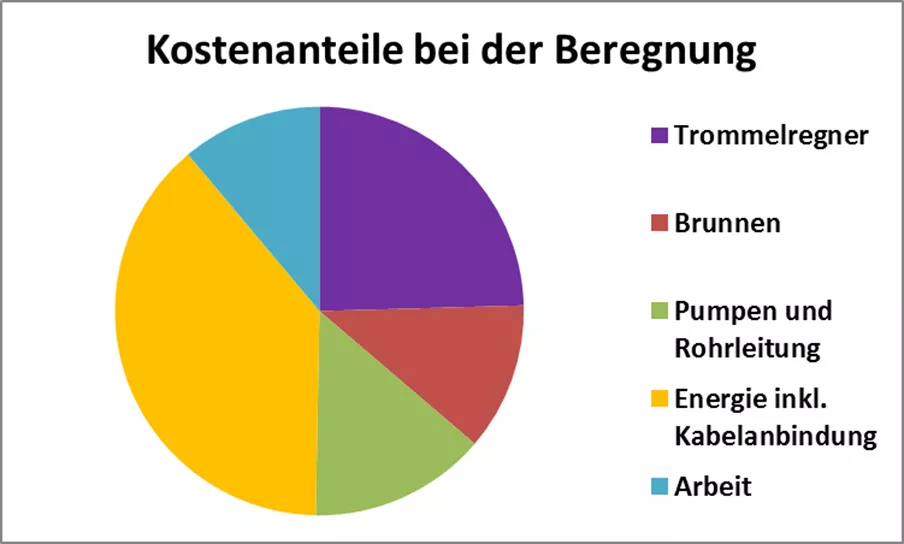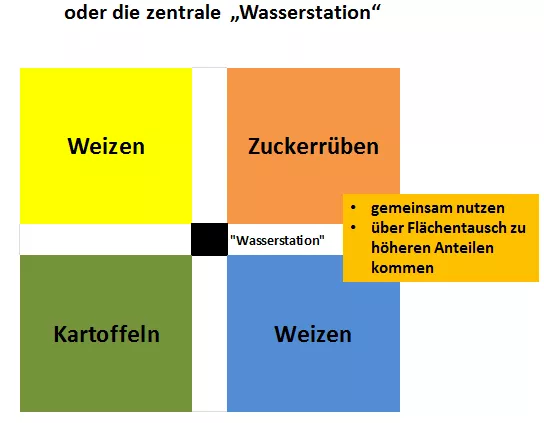Western Europe is one of the best agriculture sites in the world. The conditions of production, the Know-How of the plant manager, the proximity to the market and logistics are looking for their peers. Still, Too wet or too dry, rarely fits the weather for the special period and location. In the future, it will not be better. On the contrary, the weather extremes may increase. The relatively expensive site demands also improved production conditions, therefore probably the one who "targeted" can lead to water. There are many economic reasons for an irrigation economic reasons for a watering. Here are the additional income as well as quality assurance and hence a secure performance of the contract in the foreground. Producer prices increased significantly in recent years and thus a higher revenue potential or even potential loss increase the profit margin. At the same time, we can see increasing periods of extreme drought and evaporation in yield-sensitive phases despite our good climatic conditions. Rising lease costs by increasing land scarcity demand higher land productivity so that a reinforced "sales-intensive" crops takes place. An irrigation increases in addition to the above mentioned reasons the production and thus security of supply, without which you can not commitments.The problem is the availability of or the procurement of water often. Of course it would also be nice, if there were greater irrigation blocks (from 50 ha) in the operation. Maybe you can talk to but also the field neighbors. The removal from surface water is often only Very much restrictive approved, while groundwater is Very much deep or inaccessible. A watering worthy culture in every second year would be attractive, but also every four years it can pay off according to individual requirements. All cultures that have a time-critical water need and promise higher sales are eligible for irrigation. The cost of irrigationthe largest cost factor represents energy necessary for the water collection and distribution, where the question whether power is present or diesel must be taken, the well depth and the discharge and distribution technology are the decisive cost-formative parameters. Followed by the direct fountain, pump and labor costs - you are in turn highly dependent on application technology - as it can be seen from the graph of the cost share for the irrigation. The variable costs and the fixed costs keep the balance in about. While the fixed costs are heavily dependent on the possible scope of the sprinkler fitting surfaces, the variable energy and work only when the use costs. The fixed costs consist of wells, pump unit for diesel or electricity, Earth, fire hydrants and irrigation machines together and move between 100 and 200 euro / ha depending on the conditions locally and by the type of distribution, but in particular by the extent of the irrigation unit. In Central Plains irrigation blocks are attractive from 50 ha 100 ha.The variable costs for energy and work of "translation to" move frequently between 1 to 2 euro / mm depending on the type of energy (electricity or diesel), the distribution technology (energy and work) and the "force" of the expenses for the water supply (E.g. well depth). The current solution is the significantly cheaper version.Average the "means" of cultures lies between 50 mm to 150 mm in two to five part offerings. Thus, the variable costs are on average 150 euro / ha, fall but only if they bring immediate benefits. Clearly, The work on the implementation of the technology is bulky and inconvenient, but extremely fruitful. The benefits of irrigationas already mentioned significant extra income and better quality and thus more revenue depending on the crops grown are the targeted monetary benefits. Of course, the potential additional revenue expectations are Very much different depending on the location, year and particularly culture. The following model calculation assumes following assumptions:
- Potatoes: 15% more revenue (set, oversize)
- Sugar beet and maize: 7.5% surplus
- Wheat: 10% and barley up to 5% more yield
In the model statement is, that the irrigation capacity for 25% of the area exists in the"irrigation". Can be seen on the basis of the model calculation, that irrigation not only because of increased income, but also because higher prices pays off in dry years, and Of course only with stronger sales cultures. Another important point in the discussion is the higher yield security and quality. This approach is in calculating monetarily but not rated. The cultivation of a second "watering worthy culture" in the rotation would improve significantly the result of.As a result, the question arises: what improvements/additional gains can be achieved by the extra water?Considering the model calculation for the possible added value of a sprinkler so a positive overall balance arises in dependence on the irrigated land shares, the saleable surplus and the approved prices. As shown in table 1, this overall balance is between 39-204 euro / ha for the total area consisting of wheat, sugar beet and potatoes. Increases the proportion of more intensive cultures on 50%, 75% or even 100%, which can be operated in the irrigation unit, so the profitability increased depending on the price level well above 1,000 euros / ha, as shown also from the table 1. This means that the irrigation block must be settled to the water station sent. This is a mix of various farmers in an irrigation Association benefit, so that the water is only used by "grateful" cultures. Two and three are each different in the overviews or subordinated to above-average additional income, the results / the more profits are correspondingly better or worse. The statement remains: If the sprinkler for mainly sales stronger and worthy of irrigation cultures, it is highly profitable. This is a central water station, i.e. a variable water availability of great importance. Bottom line: often an irrigation investment have paid off dry years in 1-2. The variable costs, in particular for the work of "translation to" are high, but experience has shown that bring a "good interest". In dry years, who then produces income and quality earning good money. In years of plenty of water brings nothing to the irrigation, the var but also costs less, there. Cost for energy and implement not incurred. Often total 50 mm are distributed to 100 mm of water at the right time the ultimate yield and quality factor, i.e. a corresponding "insurance" is possible with 200-400 euro / ha. Get your irrigation water as soon as possible before others do it (to himself), investment in water-saving and conservation techniques are often more expensive, can count but still on time! In brief, it should be noted:
- A scarce and expensive area requires an intensification of production
- A possibility of irrigation influenced the impairment of land
- The sprinkling of 'Intensive cultures' is profitable
- A sprinkler for only grain and oilseed rape crop rotation is not profitable
- A higher proportion of cultures worthy of irrigation or a coordinated use of available water resources reduces costs
- A reliable production allows better marketing results
- Water is an increasingly important factor of production, there are water - and soil-friendly application techniques to prefer



